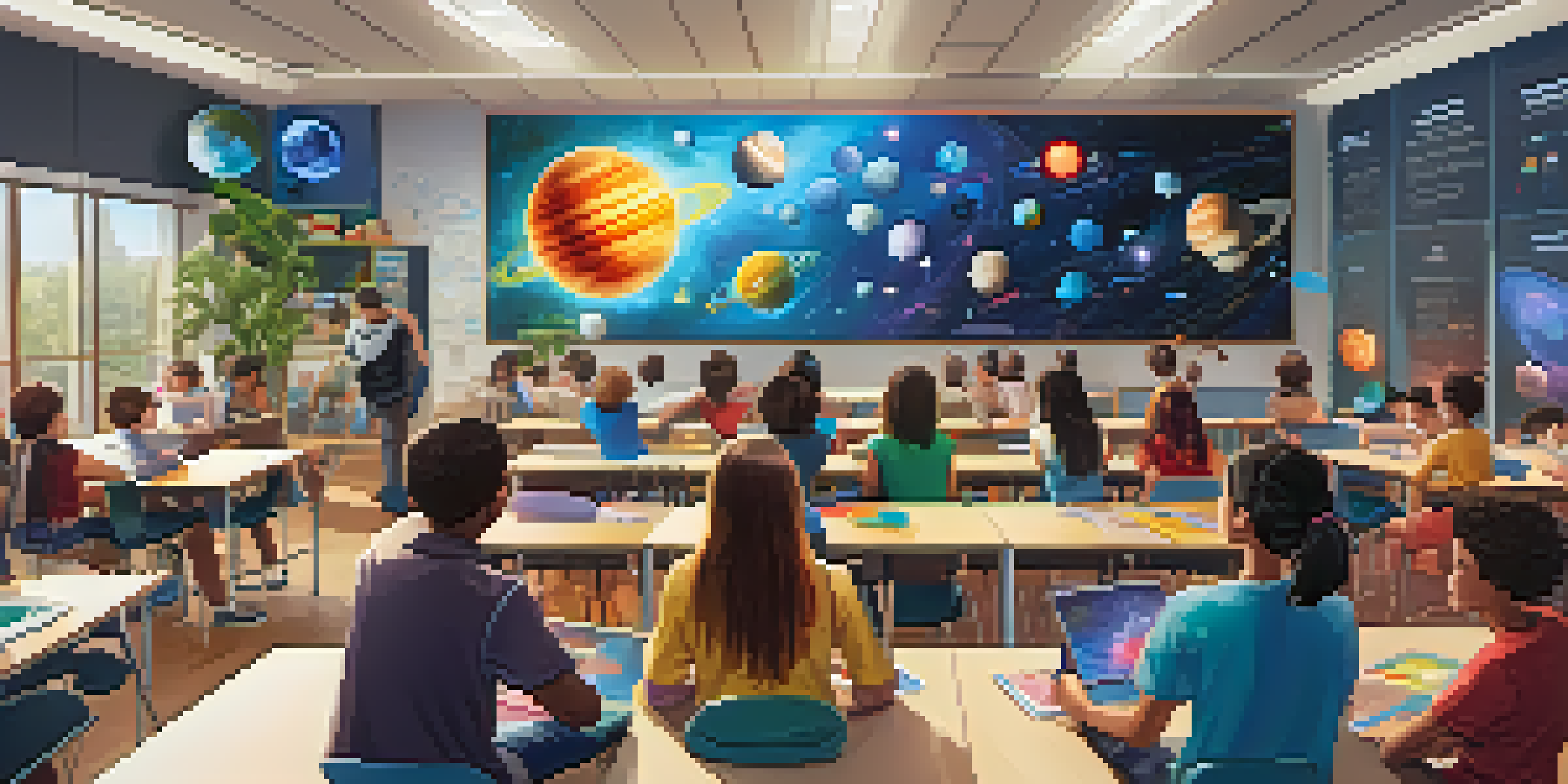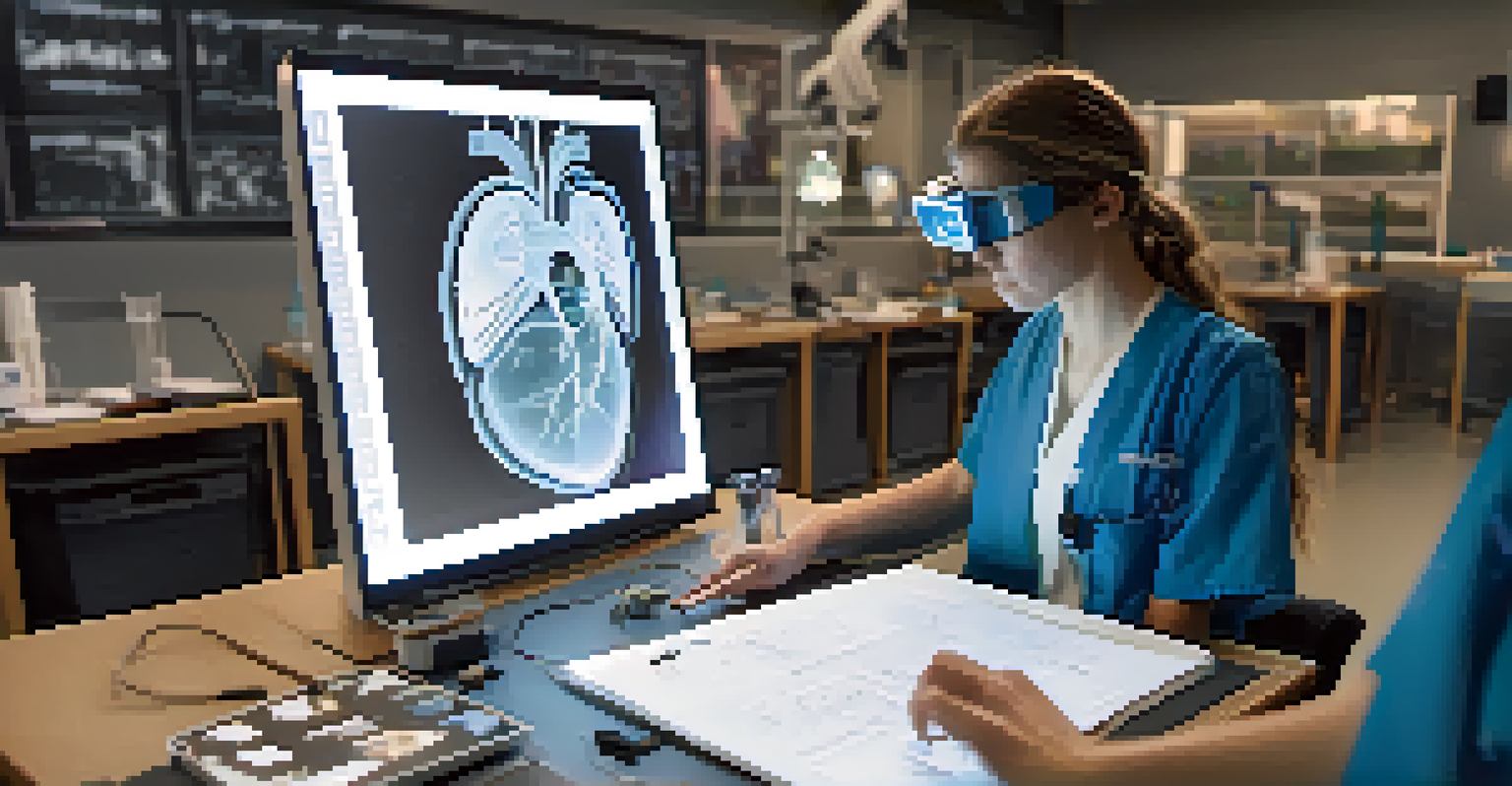Measuring the Impact of AR on Learning Outcomes

Understanding Augmented Reality in Education
Augmented Reality (AR) is a technology that overlays digital information onto the real world, enhancing our perception of reality. In education, this means students can interact with 3D models, animations, and other digital content right within their physical environment. Imagine learning about the solar system and being able to see planets orbiting around you in real-time, making the experience not only educational but also highly engaging.
Augmented reality is a way to enhance the real world with digital content, allowing for interactive experiences that can transform learning.
This immersive interaction helps bridge the gap between theoretical knowledge and practical understanding. For instance, medical students can use AR to visualize complex human anatomy without the need for cadavers. By providing a hands-on learning experience, AR transforms traditional educational practices into dynamic and interactive lessons.
As more institutions adopt AR, understanding its impact on learning outcomes becomes essential. Measuring this impact can reveal not only the effectiveness of AR tools but also how they can be improved to better serve students. The goal is to determine if AR truly enhances learning, retention, and comprehension of material.
Key Benefits of AR in Learning Environments
One of the most notable benefits of AR in education is increased engagement. When students interact with augmented content, they are often more motivated to learn and participate in lessons. This heightened interest can lead to better retention of information, as students are likely to remember experiences that captivated their attention.

Furthermore, AR caters to various learning styles. Visual learners, for example, can benefit immensely from seeing concepts represented in 3D, while kinesthetic learners can interact with models and simulations. This inclusivity fosters a more effective learning environment where all students can thrive, regardless of their preferred learning method.
AR Enhances Engagement in Learning
Augmented Reality captivates students' attention, leading to improved motivation and retention of information.
In addition to engagement and catering to diverse learning styles, AR can also facilitate collaborative learning. Students can work together in augmented spaces, allowing for teamwork and peer-to-peer engagement that traditional methods might not support. This collaboration not only boosts social skills but also enhances problem-solving abilities.
Challenges in Implementing AR in Education
While AR holds great promise for enhancing learning, its implementation comes with certain challenges. One primary concern is the cost of AR technology, which may not be feasible for all educational institutions, particularly those in underfunded areas. Budget constraints can limit access to the latest tools, hindering the potential benefits of AR-based learning.
The future of education lies in immersive learning experiences that engage students and foster deeper understanding.
Technical issues also pose a significant hurdle. Schools may experience difficulties with software compatibility, hardware malfunctions, or a lack of reliable internet connectivity. These challenges can disrupt lessons and frustrate both educators and students, leading to diminished enthusiasm for AR initiatives.
Moreover, educators must be adequately trained to integrate AR into their teaching practices effectively. Without proper training, teachers may struggle to utilize AR technology to its fullest extent, resulting in missed opportunities for enhancing the learning experience. As a solution, professional development programs focused on AR usage can empower educators and help them navigate these challenges.
Measuring Learning Outcomes with AR
To assess the impact of AR on learning outcomes, educators can employ various measurement techniques. Pre- and post-tests are common methods to evaluate knowledge retention, allowing for a direct comparison of student performance before and after AR interventions. This quantitative data can provide valuable insights into the effectiveness of AR tools in enhancing learning.
Another approach is to gather qualitative feedback through surveys and interviews. By asking students about their experiences with AR, educators can gain a deeper understanding of how the technology influences their learning journey. This feedback can inform future AR implementations and highlight areas for improvement.
Challenges in AR Implementation
Cost, technical issues, and the need for educator training are significant hurdles that schools face when integrating AR technology.
Additionally, analyzing classroom engagement metrics, such as participation rates and collaboration levels, can also shed light on AR's impact. By observing how students interact with AR content compared to traditional methods, educators can better gauge the effectiveness of this innovative approach to learning.
Case Studies Highlighting AR Success Stories
Several educational institutions have seen remarkable success in implementing AR to improve learning outcomes. For example, a university's biology department used AR to teach complex concepts like genetics through interactive simulations. Students reported increased understanding and interest in the subject matter, showcasing AR's potential to enhance learning.
Another case study involved a high school that integrated AR into its history curriculum. By allowing students to explore historical sites and events through augmented experiences, engagement soared, and students demonstrated improved performance on assessments. These real-world examples illustrate how AR can transform traditional education into something truly dynamic.
These success stories pave the way for further exploration and adoption of AR in various educational settings. As more educators share their experiences and results, the evidence supporting AR's effectiveness will continue to grow, encouraging others to embrace this innovative approach to learning.
Future Trends in AR and Education
As technology evolves, so too will the capabilities of AR in education. Future trends may include the development of more sophisticated AR applications that can provide personalized learning experiences. Imagine an AR system that adapts to each student's learning pace and style, offering tailored content that meets their individual needs.
Moreover, advancements in hardware, such as lightweight AR glasses, could make AR experiences more accessible and immersive. This evolution could revolutionize the classroom environment, allowing for seamless integration of AR in daily lessons without the limitations of current devices.
Measuring AR's Learning Impact
Employing pre- and post-tests, as well as gathering qualitative feedback, helps educators assess the effectiveness of AR tools in enhancing learning outcomes.
Finally, the expansion of AR-related professional training for educators is likely to increase. As more teachers become proficient in AR technology, its implementation in classrooms will become more widespread. This growing expertise will help maximize the potential of AR to positively impact learning outcomes across diverse educational settings.
Conclusion: The Transformative Power of AR in Learning
In conclusion, Augmented Reality has the potential to transform educational experiences, making learning more engaging, interactive, and effective. By bridging the gap between theory and practice, AR can help students grasp complex concepts and retain information more effectively. The benefits of AR, from increased engagement to catering to diverse learning styles, are significant.
However, challenges such as costs, technical issues, and the need for educator training cannot be overlooked. Addressing these hurdles is essential for maximizing the benefits of AR in education. By investing in training and resources, institutions can create a supportive environment for both educators and students alike.

Ultimately, as we continue to explore and measure the impact of AR on learning outcomes, it becomes clear that this technology holds immense promise. With the right approach, AR can not only enhance educational experiences but also prepare students for a future where digital and physical worlds increasingly converge.